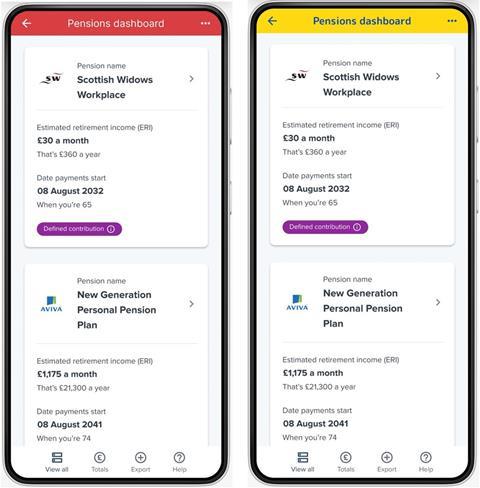Independent pensions dashboards consultant Richard Smith speaks to Aviva in this latest instalment exploring how providers are preparing for pensions dashboards over the next few months.
Each month, I’m exploring how one of my own pension schemes or providers is getting ready for dashboards, as a way to illustrate how the industry as a whole is preparing.
In each article, I’m uncovering a new topic, issue, or complexity that consumers will need help with.
Episode 1 (on my active Nest pension) covered the clash between dashboards leading with ‘estimated retirement incomes’, whereas apps today typically lead with pot value. Will consumers understand this difference?
Episode 2 (on my active Scottish Widows pension) illustrated how different pensions on dashboards will have different (notional) payment dates and different “as at” dates. Again, will this confuse consumers?
Pension 3: Aviva
We’re now going to start travelling back in time through my pensions from previous jobs, eventually getting back to the 1980s, when my career started – in Episode 9, due to be published in April 2025.
My third pension is an individual personal pension with Aviva. But it didn’t start out that way.
I got a job with PricewaterhouseCoopers (PwC) in 2003, and shortly after starting work there, I chose to join the firm’s pension arrangement – a group personal pension (GPP) plan provided by Winterthur Life. (This was nearly a decade before automatic enrolment started, so I had to choose.)
In 2006, Axa bought Winterthur, then in 2011 Axa merged with Friends Provident to make Friends Life, which itself was acquired in 2015 by Aviva.

I’m a nerd, so I’m fully aware of how my pension providers have merged over the years, but how many consumers will understand this, especially as corporate mergers like this are really quite common?
How well will most consumers even recognise the current name(s) of their older pension provider(s)?
An individual contract
After I left PwC, my pension in what was then the Friends Life GPP subsequently became an individual personal pension with Aviva, as I was no longer an active member of the GPP.
It’s also regulated by the Financial Conduct Authority, unlike my Nest pension, which is regulated by the Pensions Regulator. Which normal consumers will understand, or even care about, that subtlety?
Hopefully, dashboards will be a further force for ever-closer alignment of the two regulatory regimes.
Choosing to use Aviva’s dashboard
Aviva plans to introduce a commercial dashboard (often referred to as a qualifying pensions dashboard service, or QPDS).
“We are now evaluating external [dashboard] products with a goal of bringing to market an Aviva pensions dashboard that can evolve with user feedback and can adapt as standards and regulations develop.”
Emma Douglas, Aviva
Emma Douglas, wealth policy director at Aviva, said: “We are now evaluating external [dashboard] products with a goal of bringing to market an Aviva pensions dashboard that can evolve with user feedback and can adapt as standards and regulations develop.”
As a consumer, I will have a choice of dashboard.Episode 2 explained how I might choose to use the Scottish Widows dashboard, but I could also choose to use the Aviva dashboard.
Here’s how they might look:

Spot the difference? That’s right – apart from the Scottish Widows red and Aviva yellow banner at the top, they’re identical!
This is really important to understand. The Pensions Dashboards Programme (PDP) Data Standards and Design Standards dictate respectively what pension information all dashboards must display and how they must display it.
This means all dashboards’ core “Find and View” displays are going to look very largely the same. I won’t be choosing one dashboard over another because I like it more, as they’ll all be the same.
The best support will secure my gaze
Personally, I’ll be drawn to the dashboard provider (either Scottish Widows or Aviva) that surrounds its dashboard with the best guidance and support for me.
I’m 57, so I want to start thinking about how and when I could bring my different pensions into payment. The provider that helps me with this most simply, in plain terms I can understand, will be the one I go for. My eyeballs are up for grabs.
Emma Douglas said: “The option to include Post View Services such as advice, guidance, modellers, calculators or similar tools to support and improve pension savers understanding and awareness is a highly valuable benefit of a [dashboard] and is something we continue to explore.”
Multiple dashboards, with different additional services on offer, means we’ll see extensive innovation to serve different consumer segments ever better, competing for their attention and driving up engagement.
This explains why more and more firms are planning to offer a dashboard and then build wider services around it.
In the first article, I explained how there will be many dashboards, but with more providers announcing in September, we’re now into double figures, with more expected to announce.
Aviva’s data connection progress
As well as making progress with its ‘front end’ commercial dashboard, Aviva is busy preparing to connect my pension data (and all other Aviva customers’ pension data) at the ‘back end’ by April.
Emma Douglas said: “Since 2021, Aviva has been working as a PDP volunteer participant [as both a data provider and a dashboard operator]. We’re excited about moving into the next phase, where industry will connect millions of pension scheme members to their pensions.”
In its data matching rules, Aviva is adopting the Data Matching Convention guidance from the Pensions Administration Standards Association (PASA). Its matching rules will also cater for previous names and previous addresses to maximise the potential of finding pensions.
When I see my Aviva pension, on whichever dashboard I eventually choose to use, the estimated retirement income returned by Aviva and displayed to me will be as at the date of my last annual statement.
This aligns with the Nest and Scottish Widows approaches, but it does mean what I see could be several months out of date, and out of date by different periods to my other pensions shown.
This is why the industry is working in close collaboration with the Money and Pensions Service to ensure when amounts are displayed, on both the MoneyHelper dashboard and commercial dashboards, there are clear explanations to minimise consumers’ potential confusion.
Testing is everything
Emma Douglas concluded: “The consumer testing phase, before public launch, will provide good insights into the potential consumer queries, demand themes, and any operational requirements […] with feedback from the people who’ll be using dashboards to find their pensions and engage more fully with what they have.
“We anticipate many consumers will want to access information, update personal details, and consider making changes to their pensions by using online services and tools already available.
“We believe this will bring many benefits to pension savers so Aviva fully supports the introduction of pensions dashboards in the UK.”
My emerging total pension picture
My Nest, Scottish Widows and Aviva pensions will all be connected to the dashboards ecosystem in just 30 weeks’ time. This will enable live testing to commence leading, in due course, to the eventual launch of dashboards to the general public.
For me, this is building an ever more complete picture of the total estimated retirement income that I can expect in retirement.
The real beauty of pensions dashboards, however, is their comprehensive coverage across the entire UK pensions universe (except for schemes with fewer than 100 members, which are exempt).
Next month’s article will look at my fourth and final defined contribution (DC) pension and will explore some of the key issues consumers may encounter when trying to interpret the incomes they are shown.
Richard Smith is an independent pensions dashboards consultant.
Dashboards Nine-Nine: How Nest is preparing for connection day
- 1
- 2
- 3
 Currently reading
Currently readingDashboards Nine-Nine: Aviva’s approach, and legacy DC pensions
- 4
- 5
- 6
- 7
- 8
- 9


























